Published
on 16
Aug 2024
|
All rights reserved.
|
|
|
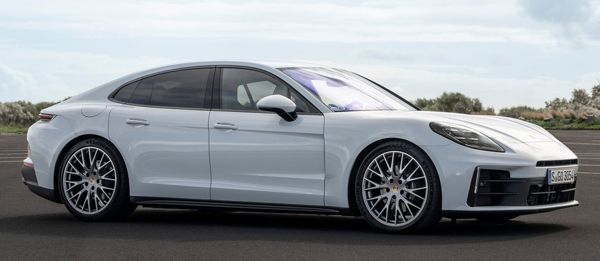
|
|
Third
gen Panamera remains a sportier choice in the luxury car segment.
|
|
Panamera has never been a
star in Porsche’s lineup. To the hardcore fans of Porsche, it is simply
too big to be enjoyed driving excitement. However, Porsche needs such a
big car to steal sales from the likes of Mercedes-AMG S-class or BMW
7-Series. Especially in China, plenty of millionaires desire to have
the Porsche badge on their luxurious daily drivers, which can take them
to workplaces comfortably yet sporty enough to distinguish themselves
from conventional rich people. Since its birth 15 years ago, the
Panamera consistently captures around 30,000 sales annually, good
enough to justify its business case. Moreover, the sporty limousine is
built on the platform of the higher volume Cayenne, so it is not as
expensive to develop and build as a dedicated model like Maserati
Quattroporte.
The third generation Panamera should be even cheaper to develop than
its predecessors, because it carries over the last generation platform.
This can be easily seen from its virtually unchanged dimensions and
silhouette. The exterior styling evolves a little bit though. Its front
end gets a bit more angular, employing squarer LED headlights. The
front fenders are more pronounced to mimic 911, but unfortunately the
nose
doesn't drop low enough. With larger cooling intakes at the front
bumper and an extra intake opened above the number plate, it looks a
bit closer to Cayenne. Further back, the rear quarter windows abandon
the round shape of 911 for something like BMW’s Hofmeister kink. The
fastback tailgate flows backward and takes a waterfall drop at the now
vertical LED light stripe. Porsche design chief Michael Mauer seems
getting tired of the round, 911-style look of the second generation and
determined to inject a crisper, more angular theme into the new car.
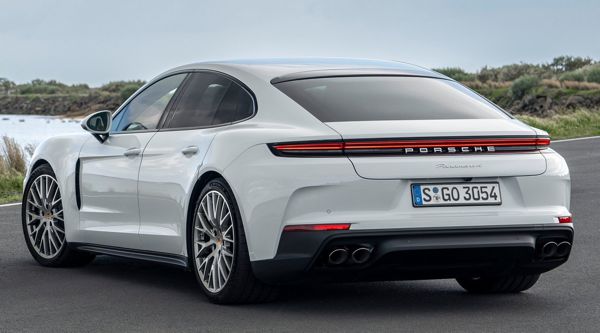
|
|
Base
car displays great balance between ride comfort and handling.
|
|
Porsche insists that 70 percent of all components are new, but the
essentials are intact. The Panamera still uses an 8-speed DCT gearbox,
something unusual in the luxurious car class but perfectly suitable to
the sportier nature of Porsche. Again only the base Panamera is
rear-drive, while others employ active all-wheel drive and assisted
with active rear differential. Also carried over is the optional
rear-wheel steering, which is quite useful to make the big car more
agile. The chassis remains a steel-aluminum hybrid
monocoque, where high-strength and hot-formed ultra-high-strength steel
are used around the survival cell and aluminum parts at front and rear
subframes as well as floorpan. The double-wishbone and multi-link
suspensions are carried over, but air springs are now fitted standard
across the board, including the base Panamera. Regrettably, it has been
downgraded from 3 chambers to 2 chambers, theoretically offering
narrower range of adjustment. However, this is compensated with new
2-valve adaptive dampers which can adjust compression and rebound rates
independently.
This biggest news to the Mk3 Panamera is perhaps a game-changing active
suspension called Porsche Active Ride.
Developed in conjunction with ZF which supplies its hardware, it is a
£7,000 option available to only E-Hybrid models. Each suspension
comprises of a single-chamber air spring integrated with ZF’s 2-valve
adaptive damper and a motor-driven hydraulic pump. The latter can pump
oil into either the compression chamber or expansion chamber of the
damper, pushing the suspension up or pulling it down at lightning speed
(up to 13 times per second !). Moreover, it can exert a force up to
1000 kg to each damper, easily countering the weight and momentum of
the car. As all 4 wheels can be independently controlled, the Panamera
may glide over bumps with very little body movement, or corner quickly
yet flatly, or brake without dive. Ride height can be adjusted
according to speed or drive mode, too. It allows the Panamera to ditch
PDCC active anti-roll bars. The only downside is power consumption,
which is up to 34 hp on really bumpy surfaces, no wonder PAR depends on
the 400V electrical system of E-Hybrid models.
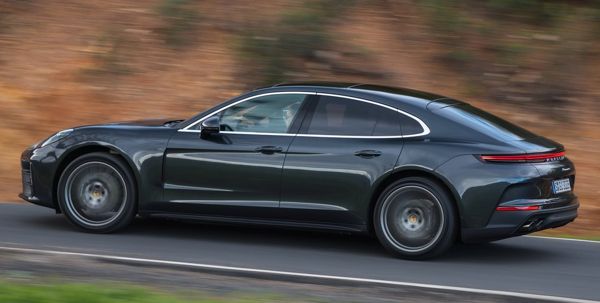 |
|
Who
really needs 680 or even 782 hp from their limousines?
|
|
On the engine side, the Mk3 keeps using the existing 2.9-liter
twin-turbo V6 and 4.0-liter twin-turbo V8 engines in conjunction with
8-speed PDK box. Compared with the last Panamera and Panamera 4, the
base V6 has gained 23 hp to 353 hp, but a higher power version is no
longer available, as Porsche sees E-Hybrid assistance as a better
option.
The V8 received some real modifications, chiefly to comply with Euro 7
emission standard without losing performance. These include replacing
twin-scroll turbos with single-scroll ones (as it absorbs less heat,
allowing the cat to get up to operating temperature quicker),
introduces 2-stage variable intake valve lift by means of switching cam
profiles as well as a higher pressure fuel injection. Losing
twin-scroll turbos might increase turbo lag, but the most heavily
boosted Turbo and Turbo S pair with a more powerful E-Hybrid system so
that low-end response is actually improved.
All E-Hybrid models use the same 190hp / 332 lbft electric motor which
is incorporated into the ZF dual-clutch gearbox and shares its oil
cooling. Battery size is nearly doubled from 14.1 to 25.9kWh, improving
zero emission range to 91 km (56 miles), which is crucial to taxation
in many countries.
By mixing the E-Hybrid system and the 2 engines in different states of
tune, Porsche manages to offer 6 Panamera models:
- Panamera or Panamera 4: V6 with 353hp, rear or
all-wheel drive.
- Panamera 4 E-Hybrid: V6 with 304hp, combined 470hp,
all-wheel drive.
- Panamera 4S E-Hybrid: V6 with 353hp, combined 544hp,
all-wheel drive.
- Panamera GTS: V8 with 500hp, all-wheel drive.
- Panamera Turbo E-Hybrid: V8 with 519hp, combined
680hp, all-wheel drive.
- Panamera Turbo S E-Hybrid: V8 with 599hp, combined
782hp, all-wheel drive.
None of them could be called slow. Even the base Panamera can do 0-60
mph under 5 seconds when equipped with Sports Chrono launch pack. Most
models take just over 3 seconds, while the flagship Turbo S E-Hybrid
needs a jaw-dropping 2.8 seconds only and reach a top speed of 202 mph,
even though it weighs a massive 2365
kg!
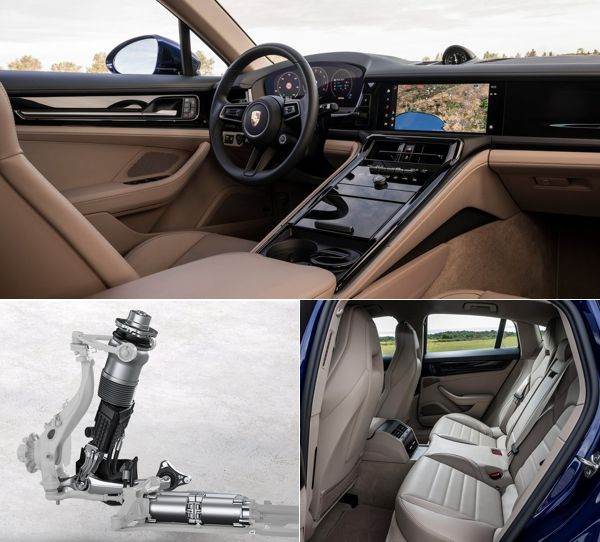 |
|
Active
Ride is game-changing...
|
|
Inside the cabin, space remains the same as before, which is a tad
smaller than
its more conventional rivals, but easily roomier than a Taycan. In
standard form the rear is configured as 2 individual seats. You may opt
for bench seat, but the unfortunate guy sitting in the middle will have
his legs blocked by the prominent transmission tunnel. Up front, the
Panamera differs a lot from your conventional AMG, most notably a low
seating position. Instead of large span of touchscreen, the Panamera’s
dashboard is more classical, even though it has ditched the old car's
conventional analogue rev counter for a fully digital instrument
display. There is an infotainment touchscreen integrated neatly into
the dashboard, not standing atop the dash like a flat panel TV or
freely like a PC monitor – thanks God. A wide and sloping center
console still dominates the transmission tunnel, but it loses the
previous gearlever (moved to paddles behind the wheel). Fortunately
some physical switches and a rotary knob survive the process of
“modernization” and continue to serve as straightforward control for
HVAC. Less amusing is the gloss black panel, which looks a bit cheap to
a luxury car like this. The fit and finish of Porsche won’t disappoint,
but materials richness will never match Bentley or Mercedes.
On the road, the base Panamera offers just about sufficient power.
Performance is never dramatic, of course, but the V6 is smooth,
responsive and quite flexible. Quiet if you don’t rev it, or plays a
tuneful note if you do, provided the optional sport exhaust is fitted.
The PDK gearbox always makes quick and smooth gearshifts. The air
suspension rides comfortably in normal mode, if not as magic-carpet as
an S-class. Only the excessive tire noise spoils its otherwise
high-standard of refinement.
On the other hand, the big Porsche is enjoyable to steer. Its steering
and brake give you a more connected feel. Its suspension strikes a
great balance between handling and ride comfort. Body movement is
clearly better controlled than its luxury rivals. Front-end bite is
remarkably strong, while traction is outstanding, even on the
rear-drive base car – now you see the extra road noise is justified.
While the Panamera is no 911 or to lesser extent a Taycan, it is still
clearly sportier than any AMG or M-badge large limousines.
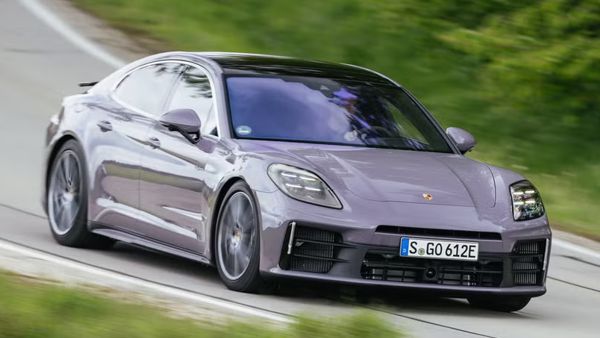
|
|
GTS
might be the sweet spot of the range...
|
|
Naturally, the Turbo and Turbo S are the performance choices. The
electric boost gives them instant throttle response and pulls the car
relentlessly from a stop to well beyond triple-figure speed. It is hard
to imagine who needs to exploit so much power on a public road. The
combination of variable all-wheel drive, active differential and
4-wheel steering works brilliantly to make the car feel smaller and
lighter than it is. You do feel its weight on hard braking or in
tighter turns on a track, but on normal roads it hides its weight very
well.
With active suspension installed, the Panamera’s body control is
magical. Bumps are dealt as if non-existent, as the car glides over
uneven
surfaces smoothly, completely unfazed. Fast corners are taken
with minimal body roll. Porsche could have counteracted the centrifugal
force with “negative roll” like Mercedes’ Active Curve Tilt (see the
last generation Mercedes S-class Coupe), but decided to skip this
function in Sport or Sport+ mode, leaving a certain degree of roll,
pitch and dive as crucial feedback to the driver. Having said that, the
main benefit of PAR remains to be comfort and composure in normal
driving. Keen drivers might feel its functioning unnatural and harder
to engage with the chassis.
If the Turbo and Turbo S feel too powerful and heavy, the sweet spot
might be GTS, which is the only model served with pure combustion V8
power. It carries a good 300 kg less yet 500 ponies are plenty for the
road. In the world of excess power and features, Porsche needs to build
more cars like this.
|
Verdict:     |
|
|
|
|
|
|
|
|
|
|
Panamera (Panamera 4)
|
2024
|
Front-engined,
RWD (4WD)
|
Steel monocoque + aluminum
|
Aluminum
|
| 5052 / 1937 / 1423 mm |
| 2950 mm |
V6, 90-degree
|
| 2894 cc |
DOHC 24 valves, DVVT, VVL
|
| Twin-turbo |
| DI |
353 hp
|
369 lbft
|
8-speed twin-clutch
|
F: double-wishbone; R: multi-link
|
| Adaptive air spring, adaptive damping |
| F: 265/45ZR19; R: 295/40ZR19 |
1885 kg (1920 kg)
|
| 169 mph (168 mph) (c) |
| 4.9 / 4.4* (4.6) (c) |
12.1 / 11.3* (11.9) (c)
|
|
Panamera 4S E-Hybrid
|
2024
|
Front-engined,
4WD, 4WS
|
Steel monocoque + aluminum
|
Aluminum
|
| 5052 / 1937 / 1423 mm |
| 2950 mm |
V6, 90-degree + electric motor
|
2894 cc, battery 25.9kWh
|
DOHC 24 valves, DVVT, VVL
|
| Twin-turbo |
| DI |
353 + 190 = 544 hp
|
369 + 332 = 553 lbft
|
8-speed twin-clutch
|
F: double-wishbone; R: multi-link
|
| Adaptive air spring, adaptive damping |
| F: 275/40R20; R: 315/35ZR20 |
2255 kg
|
| 180 mph (c) |
3.6 (c)
|
8.6 (c)
|
|
Panamera GTS
|
2024
|
Front-engined,
4WD, 4WS
|
Steel monocoque + aluminum
|
Aluminum
|
| 5052 / 1937 / 1415 mm |
| 2950 mm |
V8, 90-degree
|
| 3996 cc |
DOHC 32 valves, DVVT, VVL
|
| Twin-turbo |
DI
|
500 hp
|
487 lbft
|
8-speed twin-clutch
|
F: double-wishbone; R: multi-link
|
| Adaptive air spring, adaptive damping |
| F: 275/35ZR21; R: 325/30ZR21 |
2065 kg
|
| 188 mph (c) |
3.7 (c)
|
9.1 (c)
|
|
|
|
|
|
Performance
tested by: *C&D
|
|
|
|
|
|
|
Panamera Turbo E-Hybrid
|
2024
|
Front-engined,
4WD, 4WS
|
Steel monocoque + aluminum
|
Aluminum
|
| 5054 / 1937 / 1421 mm |
| 2950 mm |
V8, 90-degree + electric motor
|
3996 cc, battery 25.9kWh
|
DOHC 32 valves, DVVT, VVL
|
| Twin-turbo |
DI
|
519 + 190 = 680 hp
|
568 + 332 = 686 lbft
|
8-speed twin-clutch
|
F: double-wishbone; R: multi-link
|
Adaptive air spring, adaptive damping,
active suspension
|
| F: 275/40ZR20; R: 315/35ZR20 |
2360 kg
|
| 196 mph (c) |
3.1 (c)
|
7.3 (c)
|
|
Panamera Turbo S E-Hybrid
|
2024
|
Front-engined,
4WD, 4WS
|
Steel monocoque + aluminum
|
Aluminum
|
| 5054 / 1937 / 1423 mm |
| 2950 mm |
V8, 90-degree + electric motor
|
| 3996 cc, battery 25.9kWh |
DOHC 32 valves, DVVT, VVL
|
| Twin-turbo |
| DI |
599 + 190 = 782 hp
|
590 + 332 = 737 lbft
|
8-speed twin-clutch
|
F: double-wishbone; R: multi-link
|
Adaptive air spring, adaptive damping,
active suspension
|
| F: 275/35ZR21; R: 325/30ZR21 |
2365 kg
|
| 202 mph (c) |
2.8 (c)
|
6.5 (c)
|
|
|
|
|
|
|
Performance
tested by: -
|
|
|
|
|
|
|